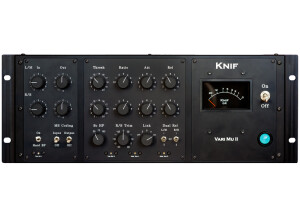Fiche technique
- Fabricant : Knif Audio
- Modèle : Pure Mu
- Catégorie : Compresseurs de studio
- Autres dénominations : puremu
Pure Mu is not a stripped-down version from Vari-Mu II. In fact, they don't have much in common internally, on the topology level. Pure Mu follows the simplest tube compressor topology, namely the one that was made famous by the most famous of them all, the name you all know. (I decided to be the first manufacturer who never uses that name in marketing) There is only one active stage of 4 parallel coupled tubes per channel, hence the name Pure Mu.
The side chain features are mostly like the ones in Vari Mu, but the time constants offer a bit more to fiddle with. The attack range goes down to extremely fast and release has a separate switch to add a second time constant in parallel, often called as "auto release". In Pure Mu this is done right. The primary release can still be chosen from the 7 positions, and "Dual" switch is used to add 2 or 4 seconds of secondary release (which can be easily customized).
The side chains are kept internally and electronically separate and share one set of controls with an adjustable link switch. What is this for? Imagine that you have very loud transient on extreme right or left. With the link control in "Off" -position, only one channel will be compressed. With the link "On" the both channels are compressed the same amount. Now, usually these options are fine enough but these are the inherent limitations: Link Off - stereo field will collapse for a moment. Link On - ALL material will follow the transient and "duck". Many times the ideal is somewhere in between. There's also another trick in the adjustable link: The channels will track each other very little during fast attack and more on release. In this way you can get the best of both worlds if it suits the material. Intermediate positions offer different degrees of linking.
As always in Knif products, there are no potentiometers. All controls use Grayhill rotary switches (Elma for input gain). Signal and power wiring is teflon insulated silver plated copper and is soldered directly to turrets on circuit boards. This combines reliable and neutral signal routing to the possibility of unlimited soldering and desoldering without damages to wires or PCB. Case is built from machined aluminum plates and blocks as usual. No bent steel plates here, thank you.
The double needle meter in the picture is an (cool but rather expensive) option. Actually great when working link "Off" and will impress the customers, ha! As in Vari Mu there are trimmers on the front panel for tube balance and meter zero. Power supply has a soft and delayed start.
All tubes in the unit are NOS without modern equivalents, but still very common and easy to get.
| Frequency response ref 1kHz | -0,5dB @ 20Hz and -0,3dB @ 20kHz |
| Input impedance | 2,5 kOhms |
| Output impedance | 150 Ohms, proper termination must be observed *) |
| Maximum output level @ 1% THD | +25 dBu |
| extremely wide soft clipping area, THD = 10% @ 30dBu output | |
| Attack time | 50us - 500ms |
| Release time | 100ms - 1s, (plus "Dual" options) |
| *) output termination: If equipment after Pure Mu has 600 Ohms input, the internal termination resistor from Pure Mu has to be removed. With the installed resistor impedances over and including 2 k are fine. |










